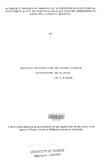| dc.description.abstract | Objective: To characterize heart failure in patients admitted to medical ward at
Kenyatta National Hospital, Nairobi.
Design: Prospective clinical observational register.
Setting: Medical ward, Kenyatta National Hospital.
Subjects: Two hundred and sixty one patients with acute decompensated heart failure
were studied over a period of six months.
Results: 261 patients with an age range of 13-94 years and most were between 20-60
years with 59.1% females. 91% of ADHF cases were in classes III and IV. Noncompliance was the precipitating factor in 83.1% of the cases, followed by infective
endocarditis at 8.5%. Out of these 40.9%,27%,18.9%,18.1%, and 7.3% had dilated
cardiomyopathy, rheumatic heart disease, Cor-Pulmonale, hypertensive heart disease,
and Ischaemic heart disease respectively. The prevalence of heart failure with normal
ejection fraction was 39.5% at an ejection fraction cut-off of 40%, average age was
49.3 ± 21.35 years with a statistical significance of p<0.006, with predominantly
systolic heart failure in males at 61.7%. Among all the cases, 21 had a QRS duration
of more than 120 milliseconds and 19 when rheumatic disease was excluded.
Increase in QRS duration was noted with increase in age, with average age being 44.6
years, 62.1 years and 64·7 years in group less than 120 ms, 120 ms-160 ms and more
than 160 ms, respectively (p<0.01) and ejection fractions were 38.5%, 43.8% and
30.05% respectively. The mean serum level of NT-proBNP among 50 cases at
admission was l3752.36 pg/ml, and 369.3 pg/ml at discharge (p<0.01). At admission
49 out of 50 cases had serum level of more than 1800 pg/ml. At discharge, based on
age related cut-offs, 10 patients were in the 'acute congestive cardiac failure likely'
likely group while, 10 cases were in the 'less likely' group. On admission, Frusemide
was used in 89% of cases, Digoxin in 77% and Spironolactone in 56.5% and on
discharge Frusemide was used in 84.8% of cases, Digoxin in 72.3% and
Spironolactone in 56% of the cases. Enalapril, Captopril and Carvedilol were used in
less than 50% of the cases. The overall case fatality rate was 14.1%. The mean length
of hospital stay was 7.1 days, the median was 6 days while the range was 2-29 days.
The case fatality rates according to disease aetiologies were: rheumatic heart disease
14.5%; hypertensive heart disease 19.1%; ischaemic heart disease 26.3%; and dilated
cardiomyopathy 9.7%.
Conclusion: Dilated cardiomyopathy was the most common cause of heart failure at
42.7%. 39.5% of the cases had heart failure with normal ejection fraction, more
prevalent among older patients. Prolonged QRS duration was evident in older age
groups. Enalapril, Captopril, and Carvedilol were used in less than 50% of heart
failure cases. At discharge, 20% of the cases were in heart failure with a raised NTproBNP level. | en |
| dc.description.department | a
Department of Psychiatry, University of Nairobi, ; bDepartment of Mental Health, School of Medicine,
Moi University, Eldoret, Kenya | |

